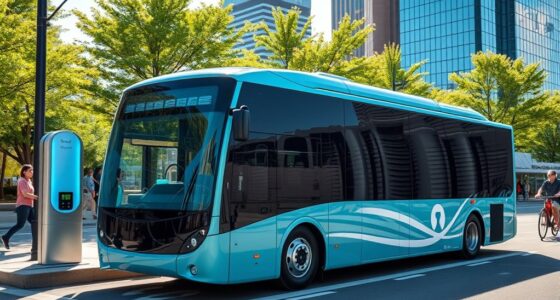Proper disposal of electric bus batteries is essential to prevent harmful chemicals like lithium and nickel from contaminating soil and water. When managed responsibly, recycling helps recover valuable materials and reduces environmental harm. It supports a circular economy, cuts pollution, and minimizes reliance on new resource extraction. By handling batteries correctly, you help protect ecosystems and public health. If you want to learn more about sustainable practices and regulations, keep exploring this important topic.
Key Takeaways
- Improper disposal of electric bus batteries can lead to the leaching of hazardous materials into soil and water.
- Recycling batteries reduces environmental contamination and recovers valuable materials, minimizing the need for resource extraction.
- Proper disposal prevents long-term ecosystem damage caused by toxic chemicals and heavy metals.
- Regulatory compliance ensures safe handling and transportation, reducing the risk of environmental accidents.
- Recycling and responsible disposal support a circular economy, lowering the overall carbon footprint of electric bus operations.

Ever wondered what happens to electric bus batteries once they’re no longer useful? When these batteries reach the end of their service life, managing their disposal becomes a critical environmental concern. If not handled properly, hazardous materials like lithium, nickel, and other chemicals can leach into soil and water, causing pollution that’s harmful to ecosystems and human health. That’s why strict regulations govern their transportation and disposal, ensuring batteries are packed and handled safely. These regulations, enforced by agencies like the U.S. Department of Transportation, aim to prevent accidents and minimize environmental risks.
The most environmentally friendly pathway for disposal is recycling. When you recycle these batteries, valuable materials such as lithium, nickel, and steel are extracted through advanced processes like those developed by Li-Cycle, which can recover up to 95% of the materials. Recycling not only reduces the need to mine new resources—conserving natural environments—but also considerably cuts down on the energy consumption and carbon emissions associated with manufacturing new batteries. Recycling technology continues to evolve, making recycling processes more efficient and environmentally friendly. Additionally, implementing sustainable recycling practices is vital to maximizing environmental benefits and ensuring long-term viability of battery recycling.
Specialized recycling facilities are essential for this process, as they can dismantle batteries safely and efficiently, ensuring hazardous components are contained and materials are recovered effectively. Recycling also supports a circular economy, where materials are reused repeatedly, reducing waste. This process prevents batteries from ending up in landfills, where they could cause environmental contamination over time.
Proper disposal and recycling efforts help lower the overall carbon footprint of the transportation sector by decreasing reliance on virgin raw materials and reducing greenhouse gas emissions linked to mining and manufacturing. Additionally, recycling helps in pollution reduction by securely managing hazardous substances, preventing them from leaching into the environment and causing long-term damage. Recycling batteries is an essential step toward sustainable transportation.
Frequently Asked Questions
How Are Battery Disposal Methods Evolving Globally?
You’re asking how battery disposal methods are evolving worldwide. You’ll see regions adopting stricter regulations like landfill bans and Extended Producer Responsibility, which push manufacturers toward recycling and second-life uses. Innovative recycling technologies, such as closed-loop and hydrometallurgical processes, improve material recovery.
Additionally, global collaboration and infrastructure investments make recycling more accessible. These changes reduce environmental harm, promote sustainability, and create economic opportunities by transforming waste into valuable resources.
What Are the Economic Costs of Battery Recycling?
Balancing battery recycling costs can be burdensome but beneficial. You’ll face transportation fees, dismantling expenses, and testing costs, all adding up.
While high-value metals boost profits, low-value batteries like LFP reduce revenue. You might offset costs through resale, government subsidies, or second-life opportunities, which extend battery usability and reduce recycling demand.
Embracing eco-friendly economics, you can mitigate mounting disposal costs while maximizing material recovery and minimizing environmental impact.
How Do Battery Disposal Impacts Compare to Fossil Fuel Emissions?
You’re asking how battery disposal impacts compare to fossil fuel emissions. While fossil fuels cause immediate air pollution, greenhouse gases, and habitat destruction, battery disposal risks involve long-term soil, water contamination, and resource waste.
Both harm marginalized communities, but through different pathways—air versus land. Managing these impacts requires regulations, recycling, and innovation, so you can minimize environmental harm across the lifecycle of transportation.
Are There Innovative Technologies for Safer Battery Disposal?
Imagine turning the challenge of battery disposal into an opportunity for innovation. You’ll find cutting-edge technologies like Li-Cycle’s patented methods, which recover up to 95% of materials, transforming waste into valuable resources.
These advancements promote safer, cleaner disposal practices, and support closed-loop recycling. By embracing such innovations, you help reduce environmental harm, extend battery life, and foster sustainable solutions that benefit both your community and the planet.
What Policies Govern Battery Disposal in Different Countries?
You should know that policies on battery disposal vary worldwide. In the EU, you have extended producer responsibility (EPR) policies requiring manufacturers to manage used batteries.
India, China, and many U.S. states follow similar regulations, promoting recycling and reuse. These policies aim to reduce waste, conserve resources, and support a circular economy.
Conclusion
As you consider the future of electric buses, remember that proper battery disposal is crucial. Did you know that over 95% of lithium-ion batteries can be recycled, reducing environmental harm? By ensuring responsible disposal, you help prevent toxic chemicals from contaminating soil and water, safeguarding ecosystems and communities. Your actions can make a real difference in minimizing the environmental impact of electric transportation, making the shift to cleaner transit truly sustainable for generations to come.









